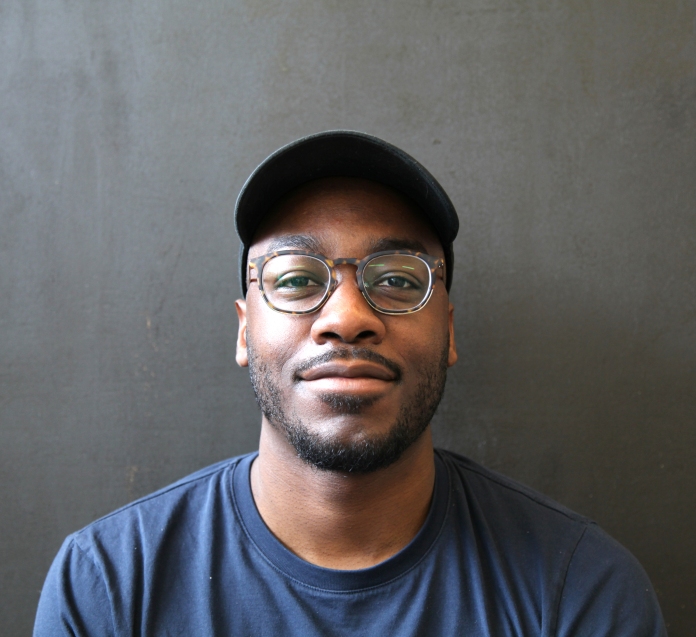
Tajh Rust is a Brooklyn based painter. He graduated from The Cooper Union in 2011 with a BFA in Painting and Film and from Yale University in 2019 with an MFA in Painting. Who has exhibited in New York, LA, Frankfurt and Brussels. Tajh was an artist that I came across while I was doing research online and the way he approached gaze in his portraits caught me instantly, I knew I had to interview him. I sat down ar with Tajh late last ye to discuss his painting over a Zoom call. In that call, we discussed many elements of his practice like his approach to portraiture, specifically the relationship with the sitter in his work, and how gaze plays a role in his paintings. It was a great experience talking to Tajh about his work, he is so considered with his answers that you gain so much in discussion with him. It a great conversation with a fantastic artist.
I’ve heard that you feel a sense of collaboration between yourself and the sitters you paint.
I usually paint people who I know personally: friends, family and people who I’ve met. And having spent time with each person, you get a sense of what’s important to them. You get a sense of their personality. I don’t want to represent people through my own prism of subjectivity. I try to approach each one individually. So that entails having conversations, asking questions like what we’re doing now. And I see if I can bring some of that into the painting itself. I had a body of work about three or four years ago, and it was strictly about looking at environments as an extension of our identities. Those paintings were set in places that each individual chose themselves, so there was a personal significance. And that then became part of the portrait; my observations of the body occupying that space.
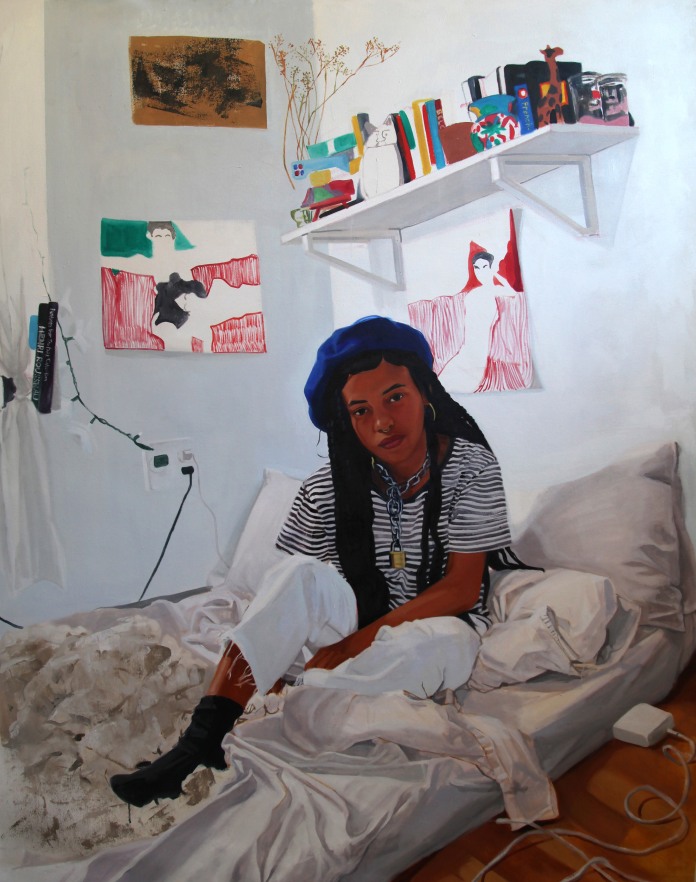
I mostly work from photographs I take of the sitter in the space. I take lots of photos of the sitters because I paint very slowly. It’s tough to get people to agree to sit for that long! I tend to work from a lot of photographs, as source imagery, and then cobble together from there.
Early on, I would try to find one photograph that I could paint from directly. Then when I started grad school, I was challenged on that approach. So, now I take more liberty in the source material. I collage different moments, kind of like a Cubist approach where you can see around things, and the perspectives may not always align, but it tends to be more faithful to a feeling of that person or that environment.
Is history an important aspect to your work?
Yeah, painting has a very long history, and it’s hard to distinguish yourself from it. If you don’t know about it, are you making some of the same decisions, the same mistakes, as your predecessors? I’ve been looking more at history in the last few years and trying to interpret it in my own way, with my own experiences.
One interesting aspect of your portraits is the use of gaze.
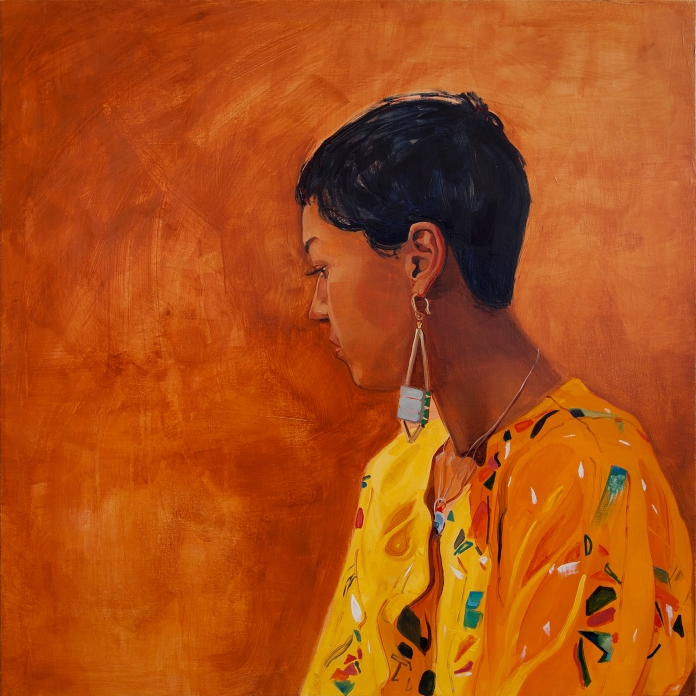
It’s something that I have to really think about when I approach a painting. I have a series of paintings where the figures are all looking away. And with those paintings, I’m trying to think about visibility in a challenging way, where the figures aren’t turned away completely; you still get enough of their likeness. But they’re withholding quite a bit. With those paintings, I usually start with a colour, often the complexion of their skin, and then build the painting from there. I wanted the figures to disappear into the atmosphere of the painting as a whole, but it’s hard to do that when they’re fully turned away, so I do a three-quarter turn.
With other paintings, the larger ones, I tried to have at least one figure confront the viewer, because I think it’s almost too easy to be a voyeur. But when the figure looks back at you or meets your gaze, it transforms this from a neutral act of looking to something more active. I like to play with that. I think it’s a completely different experience when you feel that you’re being looked at as well.
When you spend enough time looking at a painting, you can see how that painting was made. A big part of it is seeing. The recorded history that you can see by the edge of a painting, you know, how many layers; but it’s not like you’re going to crack the code or anything.
How has your practice been affected in the last year?
I didn’t travel much growing up, so it’s something I’ve prioritized as an adult, and I try to travel every year. It’s been challenging, because I haven’t been able to do that in 2020. I was fortunate enough to do a residency in Dakar (Senegal) back in 2019. I connect with people on my travels and incorporate them into my work. I love to go to museums everywhere I go. If it’s a vacation, I’ll find the nearest museum and see a show there. I think travel is a big part of my work, because I’m always trying to draw connections between people and locate myself within a larger community.
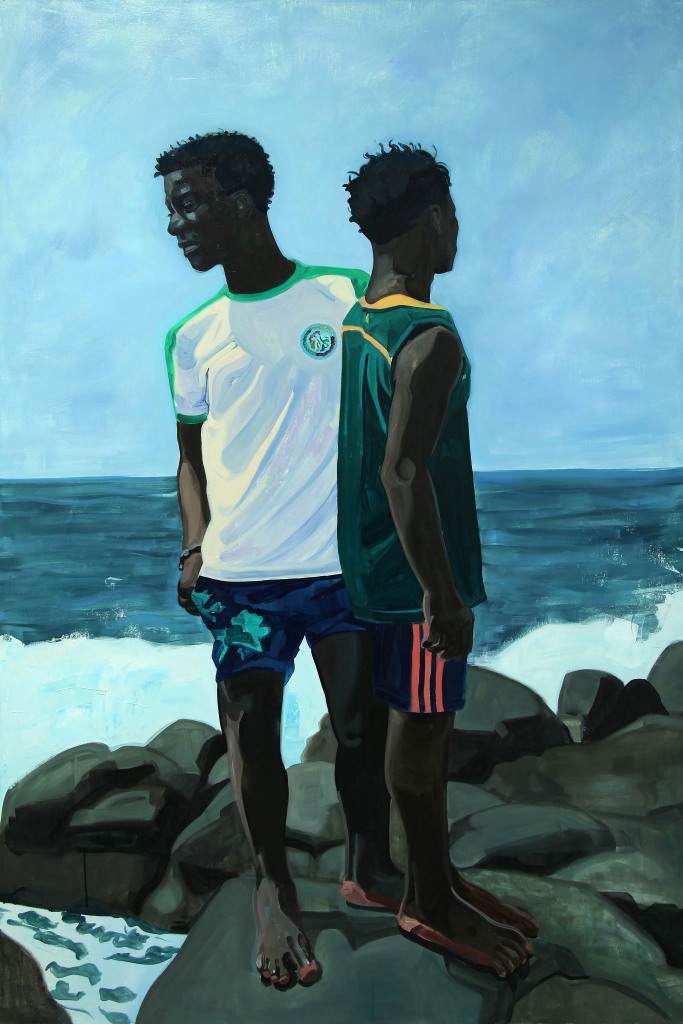
My exhibition Where We Meet came about from reflecting on some of my travels. I’d been thinking about the connections between the people I’ve met and the African and Black diaspora because they make up the majority of the subjects that I paint. So, thinking about what a shared culture amongst those people might be like. In that particular body of work, I was pulling from the residency in Dakar in 2019. It was my first time in Africa. So that’s a jumping-off point, radiating from that residency as a source. And I have also gotten to travel to Cuba, as well as the US. I was thinking about those three regions, West Africa, the Caribbean, and the United States, and trying to find connections between the people that I’ve come into contact with.
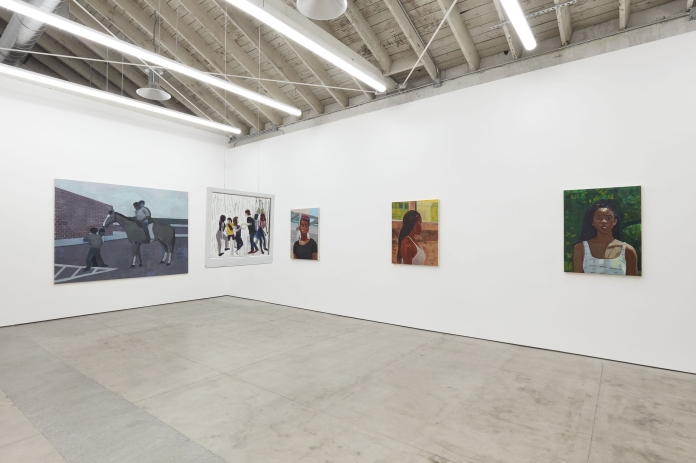
My practice has had to adapt a bit this year. I usually paint people that I know, people I get to meet in person. That’s not possible lately, because of the lockdowns. So, I’ve had to work in different ways. I have an extensive collection of images that I’ve taken on my travels and in my neighbourhood, and I’ll use those, but I’m working from drawings mostly now.
I’ve had to get creative with source materials; for instance, using film stills. I’ll watch a film, and pause at a specific moment that I think is interesting. And then I lay out an array of images and see if I can make a composition out of those references. I’ve been inspired by black and white films. For example, with Like Sunday I wanted to interpret what that setting might feel like, use it as a way to play with colour.
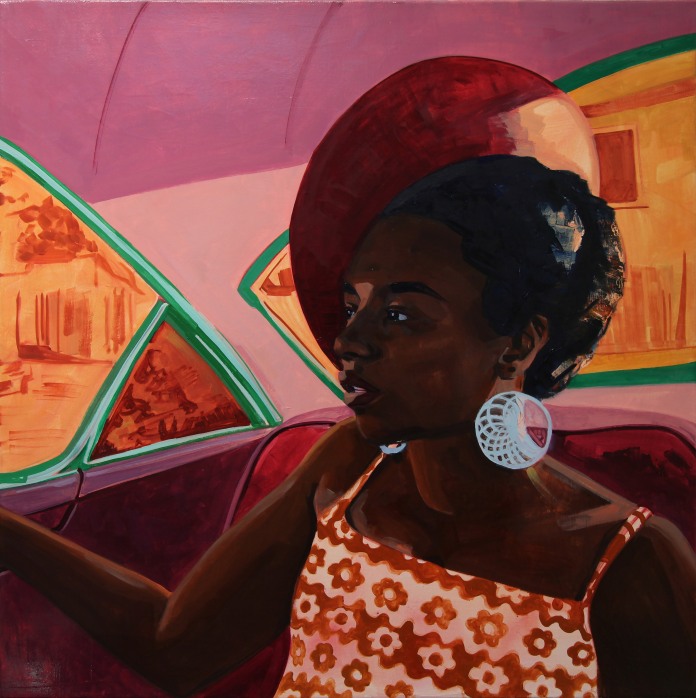
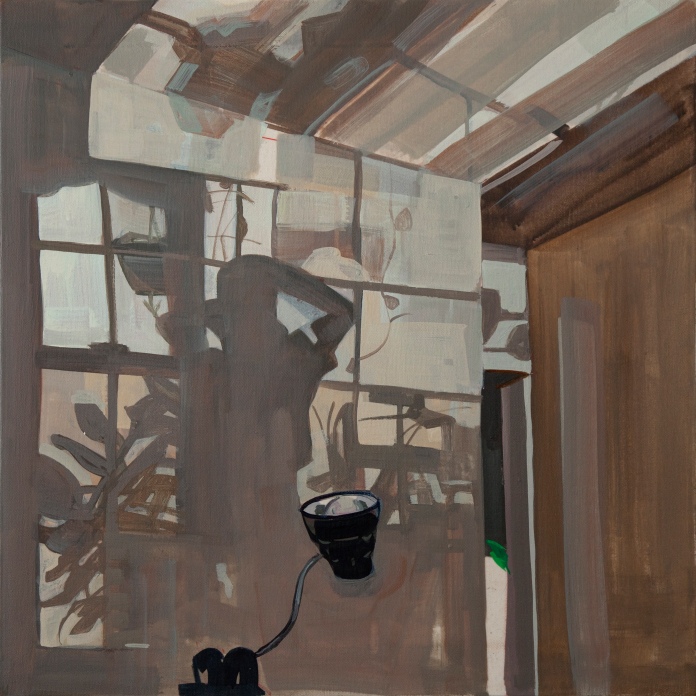
I made a couple of paintings while I was at home during the initial lockdowns. I was mostly working with drawing and thinking about what I wanted to paint, stuff that I would see around the house. I made one painting that was just shadows. I had some plants in the window, and the light was coming in through the window, and that made this pattern of shadows on the wall. And I just painted that. It was unlike anything I’d painted recently, but it was kind of therapeutic for me. It was just like, “Okay, I don’t have to worry about honouring someone’s likeness or thinking about the body in this regimented way,” so it was freeing. But it was also very difficult, because shadows are this fleeting thing that you can’t really grasp. When I paint shadows in paintings, they’re kind of made up, because they aren’t one true colour. They’re this thing that happens with light, and it’s always changing as you look at it. How do you represent that in colour? I was using acrylic paints at home, which is different from the oil paints I get to use in the studio. I don’t know if it’s a good painting, but it’s important for me because it has made me look at my environment in a different way. And it made me look at the time and paint in a different way.
I’ve noticed that in some of your works, there are older paintings within them.
It was something that evolved quite naturally over time. A few years ago, I was painting a lot of my friends as my subjects, and a lot of them are artists themselves. They would pick domestic spaces where they’d have art that they’ve collected, or their own art in the back. And I would have references to other paintings in the back as a kind of a tribute to them. It was appreciating their work by including it in mine, and it became this recurring theme. And since then, as I make more paintings, I think of how they would fit into others. Sometimes I’ll put an old painting of mine in the background of a new one, and have a dialogue. They speak to each other, which is why I try to allude to them, because they’re not separate.
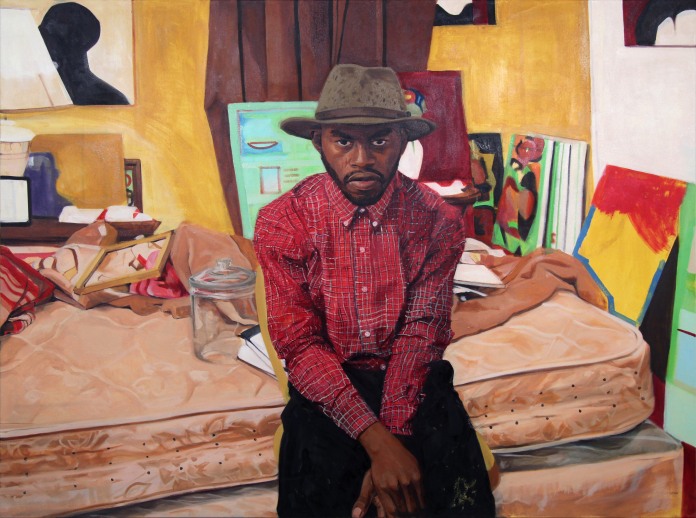
So, interpretation is something that you play with a lot in your work?
I would say so, because I am very influenced by everything that I see. I consider myself pretty sensitive to my surroundings and my environment and everything I consume visually. I used to go to museums quite often, pretty much weekly, just to see exhibitions. Not just to look at paintings, but also sculptures and film and video, and I studied film in undergraduate school. I think I watch films in a different way now, having studied them and having made a few short films. When I watch films, I think of how people are represented in film and how I can learn from that to approach the subject, the human subject and painting.
My exhibition Where We Meet was kind of influenced by a quote from Arthur Jafa, at a talk that he was giving at the Hammer Museum in LA. He was talking about the way he works, and he’s a person who collects lots of images as well. He just scours the internet. I think he used to do it manually, before the advent of the internet, where you just collect images over time, making folders and books. That’s something that I have been very interested in, because I have lots of disparate interests that may not always readily make sense together, or the connections might not always be clear between them. But the way he spoke about his interest in images from all over – he said that the justification was his interest alone, and those things make sense because he is the connector. Where the ideas meet is within each of us, and our various interests. I was always interested in that as an idea.
Is this element of representing the individual, and culture, within your abstract work as well?
I don’t work abstractly all that often. It’s when I’m faced with something I can’t quite express with the body or the figures, and it’s usually in response to something happening socially, or something we experience in the real world. Instead of a figure, I’ll use maybe colour as a stand-in for people. I’ve used a spectrum of skin tones to talk about migration, or the ways that neighbourhoods and cities are built, or representation in countries and nations. So yeah, I think skin tones as colour can provide a lot of meaning. And then it found its way back into the figurative work. With the subject paintings, I often started with the skin tone.
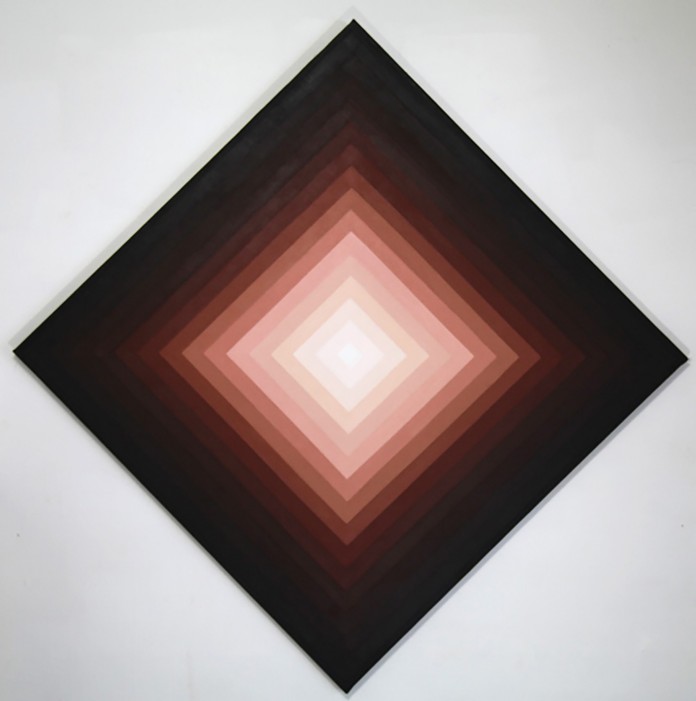
With some of your works, water seems to be a recurring theme.
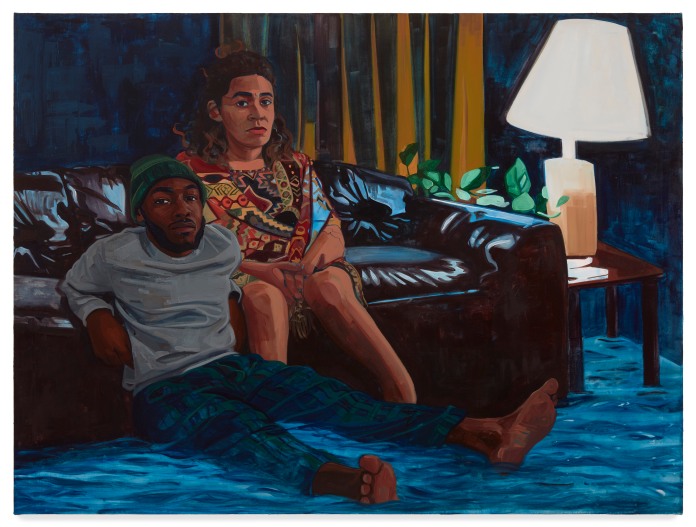
That’s a new thing that I’m thinking through. I think water is really, really magical. And it’s hard to paint, so it’s a challenge for me. Water is such a weird, crazy thing to tackle, but I think what it immediately does for paintings like Heavenly Peace and Surpassing Water’s Coolness, is it disrupts the ideas of interior and exterior. I like that, because it immediately becomes dreamlike, or ominous, by bringing water into the domestic space. It can be surreal, but it can also allude to meaning. I think of floods – quite a literal problem that has disrupted so much. Water is a clear liquid, obviously, but I use it as a colour. I tend to paint water blue, and I think blue is such an emotive colour. It immediately sets a tone, and we all have associations with blue; I love combining it with water.
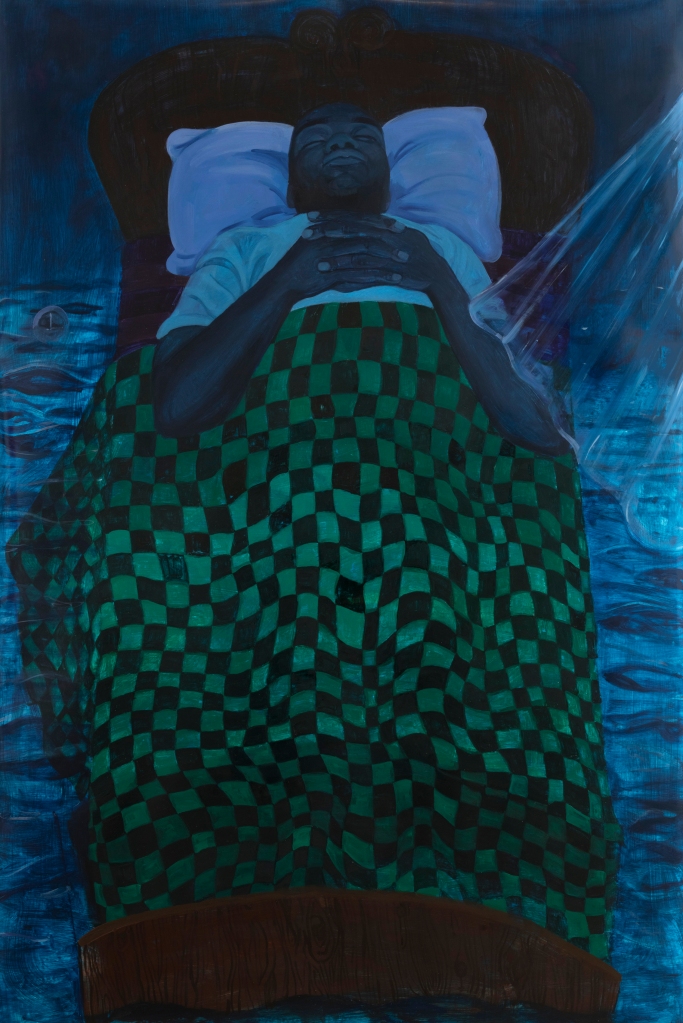
How is your work developing, going forward?
I have been interested in dreams recently, as subject matter. I have painted figures lying and sleeping in the past, and I feel that I’d like to explore what’s going on in their heads. This might help plug in a few holes in my work. I’m excited about that.
I’m painting a lot. I’m trying to get myself ready for the future. But at the moment, I just want to make some paintings that I really enjoy. And now that I have all the time in the world, I’ve got to slow down and try different things, try different challenges, and we’ll see what comes of it.
You can find out more about Tajh Rust work through his Instagram page and websites, links below
https://www.instagram.com/tajhrust/?hl=en
thank you, Anne James for your work editing
You can support Painting in Text through Patreon, link below

Great interview! Great read!
LikeLike